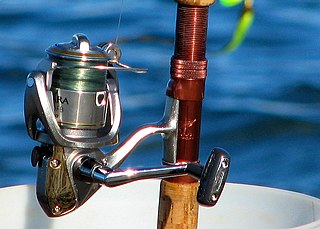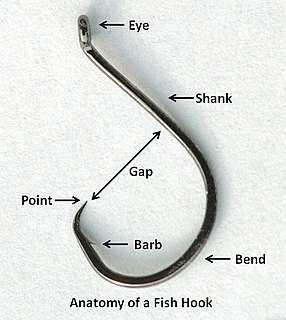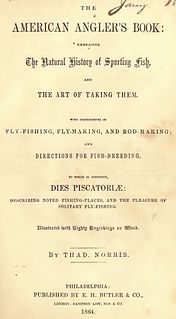Related Research Articles

Polyvinyl chloride is the world's third-most widely produced synthetic plastic polymer. About 40 million tons of PVC are produced each year.

Fishing is the activity of trying to catch fish. Fish are often caught in the wild but may also be caught from stocked bodies of water. Techniques for catching fish include hand gathering, spearing, netting, angling and trapping. “Fishing” may include catching aquatic animals other than fish, such as molluscs, cephalopods, crustaceans, and echinoderms. The term is not normally applied to catching farmed fish, or to aquatic mammals, such as whales where the term whaling is more appropriate. In addition to being caught to be eaten, fish are caught as recreational pastimes. Fishing tournaments are held, and caught fish are sometimes kept as preserved or living trophies. When bioblitzes occur, fish are typically caught, identified, and then released.

A fishing rod is a long, flexible rod used by fishermen to catch fish. At its simplest, a fishing rod is a simple stick or pole attached to a line ending in a hook. The length of the rod can vary between 2 and 50 feet. To entice fish, bait or lures are impaled on one or more hooks attached to the line. The line is generally stored on a reel which reduces tangles and assists in landing a fish.

A fishing reel is a cylindrical device attached to a fishing rod used in winding and stowing line.

A fishing line is a cord used or made for angling. Fishing lines generally resemble a long, thin string, and vary in material. Important attributes of a fishing line include length, material, weight, and thickness. Other factors relevant to certain fishing environments include breaking strength, knot strength, UV resistance, castability, limpness, stretch, abrasion resistance, and visibility. Most modern lines are made from nylon, braided polymers, or silk.

Fly fishing is an angling method that uses a light-weight lure—called an artificial fly—to catch fish. The fly is cast using a fly rod, reel, and specialized weighted line. The light weight requires casting techniques significantly different from other forms of casting. The flies may resemble natural invertebrates, baitfish, or other food organisms.

The brown trout is a European species of salmonid fish that has been widely introduced into suitable environments globally. It includes purely freshwater populations, referred to as the riverine ecotype, Salmo trutta morpha fario, a lacustrine ecotype, S. trutta morpha lacustris, also called the lake trout, and anadromous forms known as the sea trout, S. trutta morpha trutta. The latter migrates to the oceans for much of its life and returns to fresh water only to spawn. Sea trout in Ireland and Britain have many regional names: sewin in Wales, finnock in Scotland, peal in the West Country, mort in North West England, and white trout in Ireland.

Recreational fishing, also called sport fishing, is fishing for pleasure or competition. It can be contrasted with commercial fishing, which is fishing for profit, or subsistence fishing, which is fishing for survival.

A fish hook or fishhook is a tool for catching fish either by impaling them in the mouth or, more rarely, by snagging the body of the fish. Fish hooks have been employed for centuries by anglers to catch fresh and saltwater fish. In 2005, the fish hook was chosen by Forbes as one of the top twenty tools in human history. Fish hooks are normally attached to some form of line or lure which connects the caught fish to the angler. There is an enormous variety of fish hooks in the world of fishing. Sizes, designs, shapes, and materials are all variable depending on the intended purpose of the fish hook. Fish hooks are manufactured for a range of purposes from general fishing to extremely limited and specialized applications. Fish hooks are designed to hold various types of artificial, processed, dead or live baits ; to act as the foundation for artificial representations of fish prey ; or to be attached to or integrated into other devices that represent fish prey.

Fly tying is the process of producing an artificial fly used by fly fishing anglers to catch fish. Historically in England, fly tying has also been termed dressing flies. People who tie flies are called fly tyers. Fly tying is a manual process done by a single individual using hand tools and a variety of natural and manmade materials that are attached to a hook. Although the recent history of fly tying dates from the middle 1800s, fly tyers were engaged in tying flys since at least 200 AD.

Fishing tackle is the equipment used by anglers when fishing. Almost any equipment or gear used for fishing can be called fishing tackle. Some examples are hooks, lines, sinkers, floats, rods, reels, baits, lures, spears, nets, gaffs, traps, waders and tackle boxes.
Dry fly fishing is an angling technique in which the lure is an artificial fly which floats on the surface of the water and does not get wet. Developed originally for trout fishing, it is sometimes regarded as the supreme fishing sport, owing to its difficulty in both manual dexterity and understanding of the fish in its environment.

Fishing techniques are methods for catching fish. The term may also be applied to methods for catching other aquatic animals such as molluscs and edible marine invertebrates.

Fishing is a prehistoric practice dating back at least 40,000 years. Since the 16th century, fishing vessels have been able to cross oceans in pursuit of fish, and since the 19th century it has been possible to use larger vessels and in some cases process the fish on board. Fish are normally caught in the wild. Techniques for catching fish include hand gathering, spearing, netting, angling and trapping.
Fly fishing tackle comprises the fishing tackle or equipment typically used by fly anglers. Fly fishing tackle includes:

Tenkara fly fishing is a simple type of fishing practiced in Japan. Primarily used for mountain stream trout fishing, tenkara is still a fairly rare method of angling among fresh-water mountain anglers in Japan. Most use bait.

Dry-Fly Fishing in Theory and Practice (1889) is British author and angler Frederic M. Halford's second and most influential book on dry fly fishing. It followed Floating Flies and How to Dress Them (1886) and this pair of books initiated some 40 years of a rigid, and sometimes dogmatic school, the Halfordian school, of dry fly fishing, especially on English chalk streams. The work also played a significant role in the development of dry-fly fishing in America.

The Fly-Fisher's Entomology, Illustrated by Coloured Representations of the Natural and Artificial Insect and Accompanied by a Few Observations and Instructions Relative to Trout-and-Grayling Fishing, first published in 1836 by Alfred Ronalds (1802–1860), was the first comprehensive work related to the entomology associated with fly fishing. Although the work was Ronalds' only book, it was published in 11 editions between 1836 and 1913 and has been extensively reprinted in the last 100 years.

The American Angler's BookEmbracing the Natural History of Sporting Fish and the Art of Taking Them with Instructions in Fly-Fishing, Fly-Making, and Rod-Making and Directions for Fish-Breeding, to which is appended Dies Piscatoriae Describing Noted Fishing-Places, and The Pleasure of Solitary Fly-Fishing is an early American angling book by Thaddeus Norris (1811-1877) first published in 1864. Norris was known as Uncle Thad and commonly referred to in American angling history as "The American Walton".

A tube fly is a general tying style of artificial fly used by fly anglers. Tube flies differ from traditional artificial flies as they are tied on small diameter tubes, not hooks. Tube flies were originated in Aberdeen, Scotland by fly-dresser Minnie Morawski for Atlantic salmon anglers around 1945. Tube flies were designed to improve hooking success and to prevent damage to complex and expensive salmon flies by the teeth of hooked salmon. Tube flies have been widely adapted to fly patterns for a variety of cold water and warm water species and are extremely popular for steelhead and salmon in the Pacific Northwest and northeast United States, as well as saltwater species along the Atlantic, Florida and Gulf Coasts. They are widely used in European waters for Atlantic salmon, sea trout and pike.
References
- ↑ Herd, Andrew Dr (2001). The Fly. Ellesmere, Shropshire: Medlar Press. pp. 333–334. ISBN 1-899600-19-1.
- ↑ Schullery, Paul (1996). American Fly Fishing-A History. Norwalk, Connecticut: The Easton Press. pp. 209–211.



